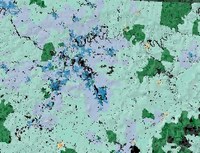Energy development
The development of coal, gas, and wind energy resources, and the physical infrastructure supporting them, represent both historical and emerging drivers of landscape change at large scales in the Appalachian region, particularly in the central and northern Appalachians.
Water — Areas where impervious surface cover and forest loss are increasing with the development of energy infrastructure are likely to experience altered surface hydrology and reductions in surface drinking water availability and quality. Waters discharged from watersheds containing mined sites commonly show elevated total dissolved solids and acidity, impairing those waters’ biological communities. Negative effects can continue for long periods after reclamation. Watersheds containing mined land show elevated runoff during heavy rains, potentially contributing to downstream flood peaks. Negative effects may be reduced or reversed with forest-restoring reclamation practices.
Soils — Soil loss and compaction associated with surface mining and some reclamation practices can impede forest regeneration. Although not widely adopted, alternative practices are available to minimize these effects.
Timber and nontimber forest products — Surface mining is expected to reduce the land area available to support working forests. This is the largest driver of land cover change in the central Appalachian coalfield region, and significant loss of timber-related economic activity can result if reclamation practices do not support forest regeneration. Restoration practices are available to mitigate these losses, but common reclamation efforts can impede forest recovery. Standing timber stocks and production have remained fairly stable in recent decades, but declines may be experienced over the long term.
Carbon storage — Forest losses associated with energy infrastructure development and surface mining are expected to result in reduced forest carbon storage. While the carbon storage potential of forest restoration on mined sites is high, successful restoration practices are not implemented on many to most sites, and some current practices may prevent significant new carbon sequestration. Assuming similar future trends in the absence of large-scale forest restoration, carbon losses from future surface mining could outstrip total regional carbon sequestration gains from existing forests.
Rural landscape values and outdoor recreation — New gas wells and wind turbines, and associated infrastructure build-out and forest loss, are expected to strongly impact landscapes in the Marcellus Shale region of the central Appalachians over the next several decades. Surface mining is the dominant driver of land cover change in the central Appalachian coalfield region, and associated forest loss, forest fragmentation, freshwater stream degradation, and other biotic and aesthetic losses contribute to the overall loss of natural landscape character when adequate ecosystem restoration activities are not in place. Stream degradation and toxic dissolved solids in watersheds with surface mines are associated with loss of fishing opportunities and represent a strong incentive for stream restoration. Reductions in game fish species abundances are associated with mine densities at local and regional scales. Concentrations of freshwater dissolved solids in watersheds with mined sites have also been associated with fish toxicity, deformity, and reduced biomass and species diversity.
 Urbanization
|
 Energy development
|
![Hemlock Wooly Adelgid By Nicholas A. Tonelli from Pennsylvania, USA (Henry's Woods (6)) [CC BY 2.0 (http://creativecommons.org/licenses/by/2.0)], via Wikimedia Commons](https://bobscapes.net/ecosystem-risks-benefits/risks/hemlock-wooly-adelgid/@@images/b0bf0bc4-1b53-4b20-8e38-e82d344bee8c.jpeg)
Invasive species and
|
 Climate change
|
![Wildfires in Eastern U.S. By Glenn Research Center (https://www.dvidshub.net/image/857727) [Public domain], via Wikimedia Commons](https://bobscapes.net/ecosystem-risks-benefits/risks/wildfires-in-eastern-u.s/@@images/0d2bbb65-9ef4-4070-a99f-c36b403f71cf.jpeg)
Wildland fire |
References
Amichev, B. Y., J. A. Burger, and J. A. Rodrigue. 2008. Carbon sequestration by forests and soils on mined land in the Midwestern and Appalachian coalfields of the U.S. Forest Ecology and Management 256(11): 1949-1959.
Campbell, J. E., J. F. Fox, and P. M. Acton. 2012. Terrestrial carbon losses from mountaintop coal mining offset regional forest carbon sequestration in the 21st century. Environmental Research Letters 7(4): 045701.
Chamberlain, J. L., S. Prisley, and M. McGuffin. 2013. Understanding the relationships between American ginseng harvest and hardwood forests inventory and timber harvest to improve co-management of the forests of eastern United States. Journal of Sustainable Forestry 32(6): 605-624.
Daniel, W. M., D. M. Infante, R. M. Hughes, Y.-P. Tsang, P. C. Esselman, D. Wieferich, K. Herreman, A. R. Cooper, L. Wang, and W. W. Taylor. 2015. Characterizing coal and mineral mines as a regional source of stress to stream fish assemblages. Ecological Indicators 50: 50-61.
Evans, J. S., and J. M. Kiesecker. 2014. Shale gas, wind and water: Assessing the potential cumulative impacts of energy development on ecosystem services within the Marcellus Play. PLOS ONE 9.
Fox, J. F., P. Acton, and J. E. Campbell. 2014. Carbon and mountaintop mining. BioScience 64(2): 81.
Fritz, K. M., S. Fulton, B. R. Johnson, C. D. Barton, J. D. Jack, D. A. Word, and R. A. Burke. 2010. Structural and functional characteristics of natural and constructed channels draining a reclaimed mountaintop removal and valley fill coal mine. Journal of the North American Benthological Society 29(2): 673-689.
Hanson, C., L. Yonavjak, C. Clarke, S. Minnemeyer, L. Boisrobert, A. Leach, and K. Schleeweis. 2010. Southern Forests For the Future. World Resources Institute, Washington, D.C.: 73 pp.
Hitt, N. P., and D. B. Chambers. 2014. Temporal changes in taxonomic and functional diversity of fish assemblages downstream from mountaintop mining. Freshwater Science 33(3): 915-926.
Jackson, L. E., B. Rashleigh, and M. E. McDonald. 2012. Economic value of stream degradation across the central Appalachians. Journal of Regional Analysis and Policy 42(3): 188-197.
Keyser, T., J. Malone, C. Cotton, and J. Lewis. 2014. Outlook for Appalachian-Cumberland forests: a subregional report from the Southern Forest Futures Project. General Technical Report SRS-GTR-188. USDA Forest Service, Southern Research Station: 83 pp.
Lindberg, T. T., E. S. Bernhardt, R. Bier, A. Helton, R. B. Merola, A. Vengosh, and R. T. Di Giulio. 2011. Cumulative impacts of mountaintop mining on an Appalachian watershed. Proceedings of the National Academy of Sciences 108(52): 20929-20934.
Merricks, T. C., D. S. Cherry, C. E. Zipper, R. J. Currie, and T. W. Valenti. 2007. Coal-mine hollow fill and settling pond influences on headwater streams in southern West Virginia, USA. Environmental Monitoring and Assessment 129(1): 359-378.
Pond, G. J., M. E. Passmore, F. A. Borsuk, L. Reynolds, and C. J. Rose. 2008. Downstream effects of mountaintop coal mining: Comparing biological conditions using family-and genus-level macroinvertebrate bioassessment tools. Journal of the North American Benthological Society 27(3): 717-737.
Townsend, P. A., D. P. Helmers, C. C. Kingdon, B. E. McNeil, K. M. de Beurs, and K. N. Eshleman. 2009. Changes in the extent of surface mining and reclamation in the Central Appalachians detected using a 1976–2006 Landsat time series. Remote Sensing of Environment 113(1): 62-72.
Wickham, J., P. B. Wood, M. C. Nicholson, W. Jenkins, D. Druckenbrod, G. W. Suter, M. P. Strager, C. Mazzarella, W. Galloway, and J. Amos. 2013. The overlooked terrestrial impacts of mountaintop mining. BioScience 63(5): 335-348.
Wickham, J. D., K. H. Riitters, T. G. Wade, M. Coan, and C. Homer. 2007. The effect of Appalachian mountaintop mining on interior forest. Landscape Ecology 22(2): 179-187.
Zipper, C., J. Burger, J. McGrath, and B. Amichev. 2007. Carbon accumulation potentials of post-SMCRA coal-mined lands, 962-980. In Proceedings of a Joint Conference of the American Society of Mining and Reclamation 24th Annual National Conference, June 2-7, 2007, Gillette, Wyoming.
Zipper, C., J. Burger, J. Skousen, P. Angel, C. Barton, V. Davis, and J. Franklin. 2011. Restoring forests and associated ecosystem services on Appalachian coal surface mines. Environmental Management 47(5): 751-765.

























